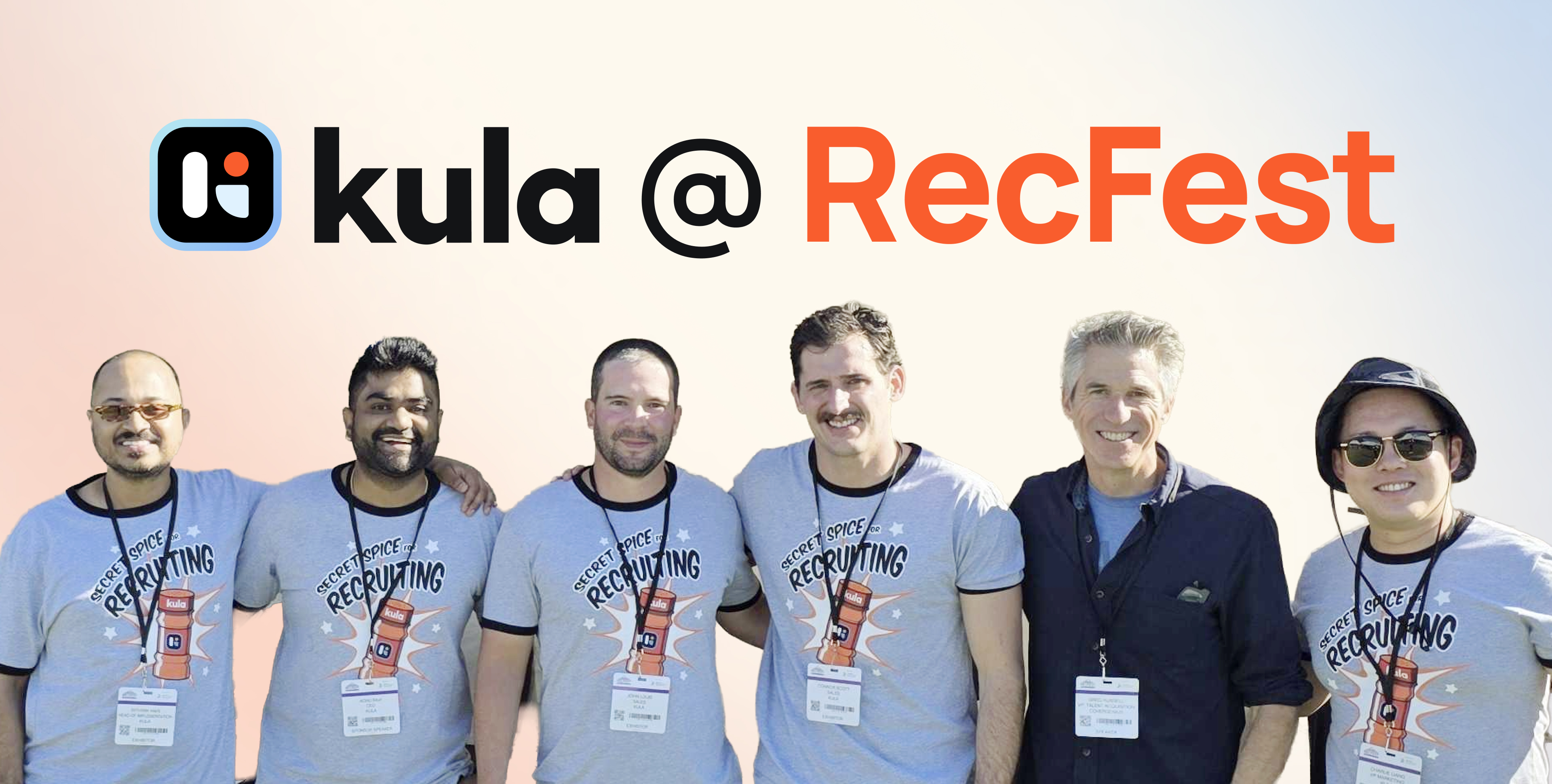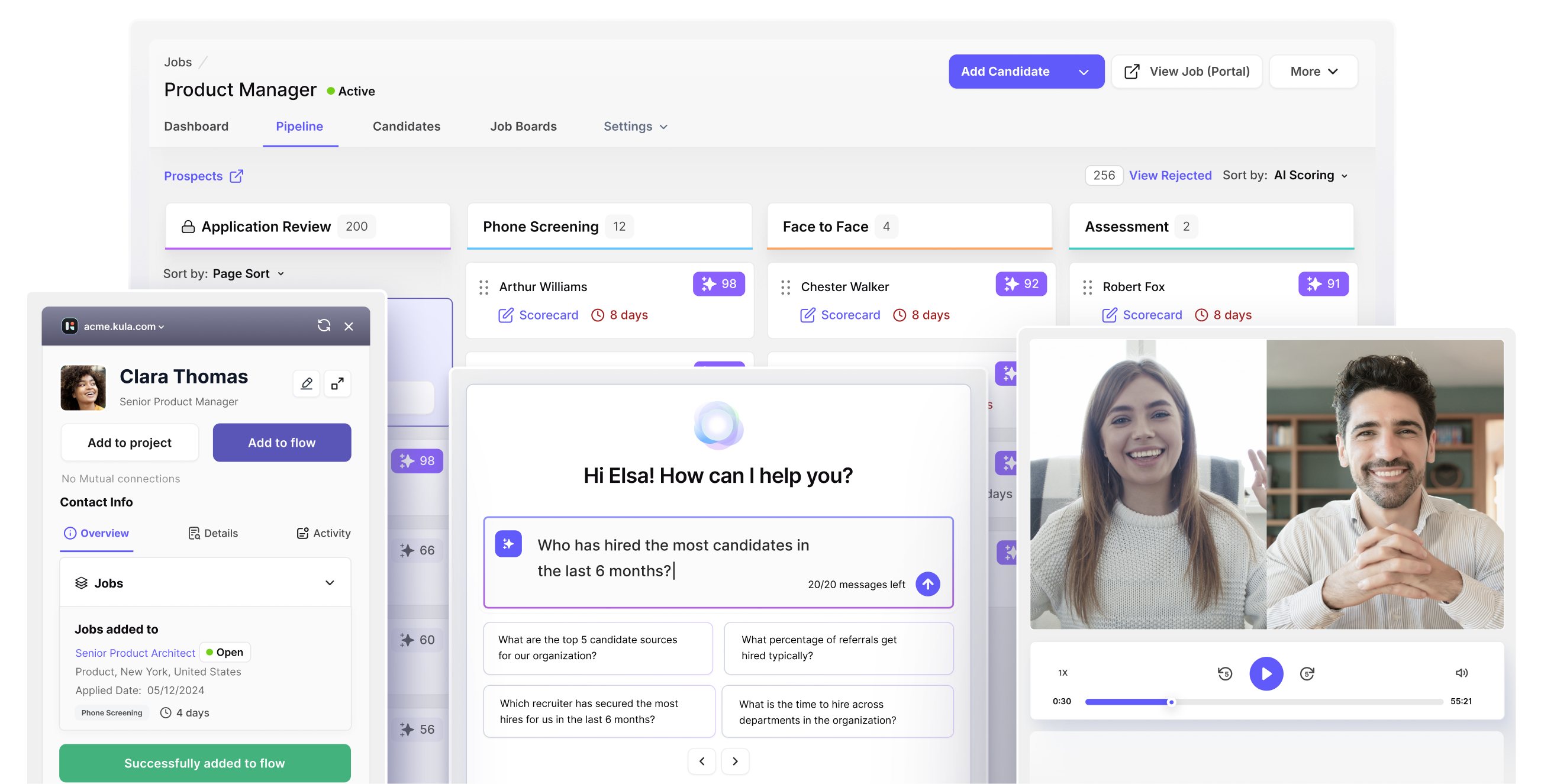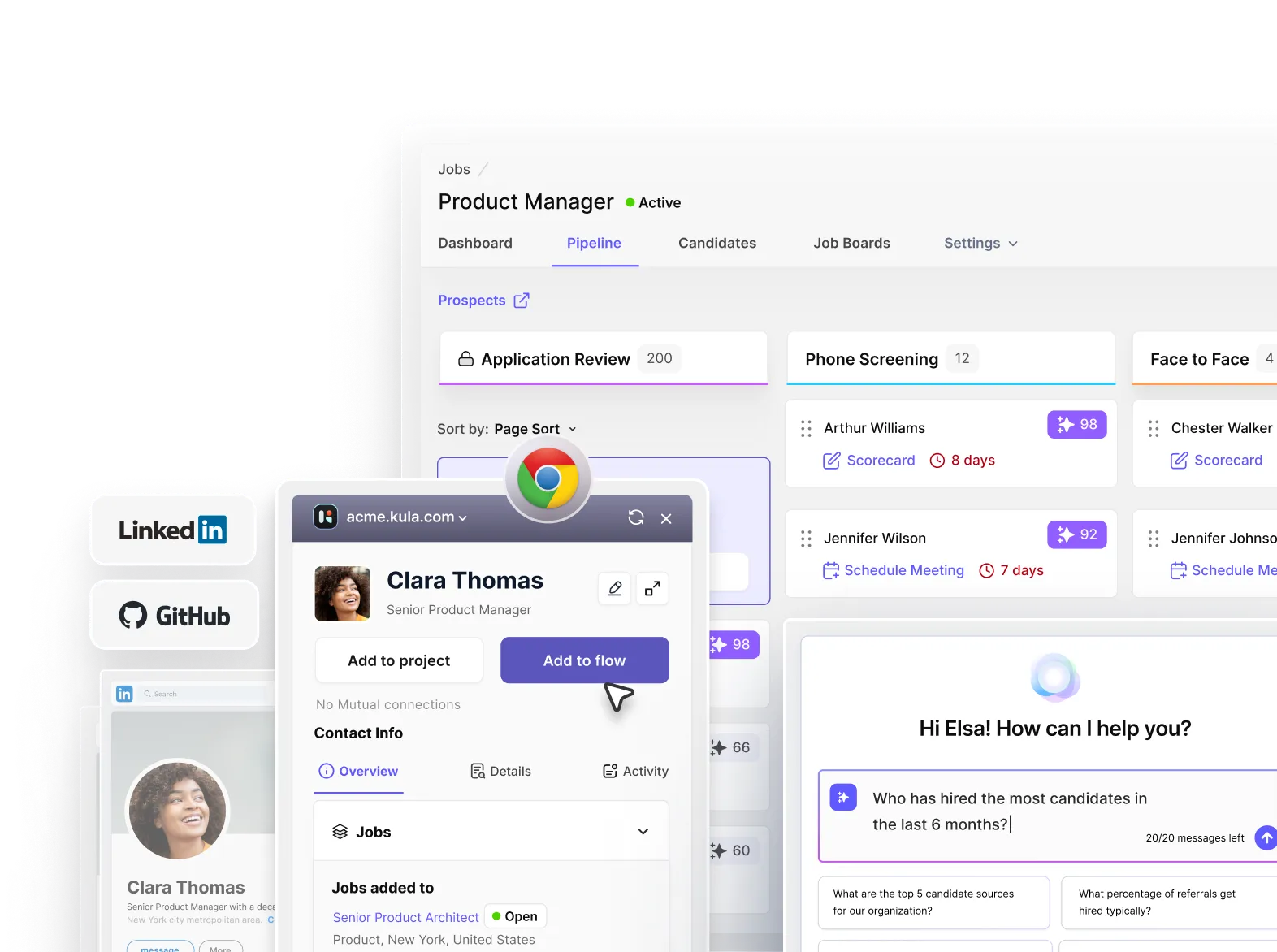Book a 30-minute demo and learn how Kula can help you hire faster and smarter with AI and automation
As organizations aim to scale or adapt to market demands, new hiring challenges are surfacing for recruiters, and traditional methods aren’t cutting it anymore.
With talent shortages at a 17-year high and candidate expectations rapidly evolving, recruiters face more pressure than ever to deliver.
And the numbers tell the real story. For instance, 74% of companies admit they’ve hired the wrong person for a role, often due to rushed or inefficient processes. And the cost of these mistakes is not just financial—it impacts team morale, productivity, and even employer branding.
This blog tackles the root causes of hiring challenges and inefficiencies. We’ll explore how AI recruiting can address these pain points and transform how hiring teams approach sourcing, screening, scheduling, and more.
The state of recruiting today
Talent acquisition is in a state of transformation. Traditional hiring practices that once worked well are no longer effective in today’s fast-moving hiring environment.

Here are some trends shaping the current state of recruiting:
1. Increased competition for top talent
The job market has become a candidate’s market. This means talented professionals have more options than ever, making it harder for employers to attract and retain top candidates.
Not to mention, the labor market is currently facing a massive skills gap, which is only adding to the competition. And this challenge in recruiting is only set to get worse.
According to Korn Ferry, by 20230, over 85 million jobs could go unfilled because there aren’t enough skilled people to take them.
2. Higher applicant volumes with limited bandwidth
Job postings often generate hundreds—even thousands—of applications, yet only a handful of qualified candidates make the cut.
Plus, sorting through this flood of resumes is extremely time-consuming and prone to errors, leading to inefficiencies and lost opportunities.
In fact, many highly qualified job seekers are overlooked merely due to the limited bandwidth of recruiters and the overwhelming volume of underqualified applicants.
3. Remote hiring and global talent pools
Remote work has expanded the geographical boundaries of talent but has introduced us to a new set of hiring challenges.
Today, recruiting teams must navigate asynchronous communication, time zone differences, and cultural nuances while ensuring an engaging candidate experience.
4. Reliance on outdated recruiting tools
Many organizations continue to use legacy recruiting software or manual methods, which lack the scalability and efficiency required for today’s complex hiring needs. These tools often result in prolonged time-to-fill metrics, dissatisfied candidates, and burnout among recruiters.
As these challenges compound, recruiting leaders are turning to technology to improve efficiency, reduce bias, and stay competitive in an evolving landscape.
This shift toward AI recruiting is becoming necessary for those who want to remain ahead in the hunt for talent and competitors.
5. Lack of data-driven hiring decisions
Recruiting decisions rely heavily on gut feelings, subjective evaluations, or outdated metrics like resumes and years of experience. While instinct and intuition play a role, the absence of reliable data often leads to costly mistakes—whether it’s hiring the wrong candidate or overlooking a highly qualified one. Without data-driven insights, recruiters and hiring managers may struggle to:
- Understand which sourcing channels yield the best candidates.
- Accurately predict a candidate's long-term success in the role.
- Identify inefficiencies or biases in the hiring process.
AI recruiting tools address this gap by turning raw hiring data into actionable insights. These tools analyze trends across sourcing, screening, and interviews to identify what works and what doesn’t.
6 common recruiting challenges hiring teams face
Recruiting is more complex today than ever before. Hiring teams juggle multiple responsibilities— managing candidate pipelines, keeping up with shifting market demands, and ensuring a positive candidate experience.
Unfortunately, bottlenecks in recruiting processes make the hunt for top talent far from seamless. Let’s break down some of the most pressing challenges that hiring teams face at different stages of recruiting.

1. Candidate sourcing: Time-intensive manual searches
The first step in any hiring process is sourcing, and this is often where the most time is lost. Recruiters spend hours scanning LinkedIn profiles, job boards, and internal databases to find potential candidates.
The problem is that manual sourcing isn’t just time-consuming—it’s also ineffective.
One-third of recruiters' time is spent searching for candidates, with 25% spending half their week sourcing for a single role. This means recruiters hardly have time left for strategizing, maintaining warm connections, and timely candidate communication.
Plus, manual sourcing doesn’t always capture passive candidates who aren’t actively applying but are highly qualified and open to the right opportunity.
As a result, identifying and reaching out to qualified job seekers is a significant challenge without the right tools.
2. Screening and shortlisting: Too many resumes to review
Did you know that 52% of recruiters think that candidate screening is the most challenging part of their job?
On average, recruiters often spend 23 hours screening resumes for a single hire, and 75% to 88% are considered unfit.
This isn’t surprising as a labor-intensive process is prone to human errors, bias, and inconsistencies, as subjective judgment plays a significant role.
These inefficiencies can delay the hiring timeline, leaving top candidates frustrated and more likely to accept offers elsewhere.
3. Scheduling interviews: Coordination chaos
Interview scheduling might seem straightforward, but it’s one of recruiting’s most underestimated pain points. Coordinating between candidates, hiring managers, and panelists often becomes a logistical nightmare, especially when multiple time zones are involved.
In fact, 56% of candidates cited delays in interview scheduling as one of their biggest frustrations during the hiring process. A slow or disorganized process can sour the candidate's experience and give the impression of a disorganized company.
Frankly, the most qualified candidates don’t last long in the job market as they are quickly snapped up due to high employer demand. This leaves a short window for hiring teams to attract the best talent.
4. Offer management: Delays and miscommunications
Even after identifying the right candidate, the process can stall at the offer stage. Misaligned expectations about compensation, slow approval processes, and unclear communication between stakeholders can all lead to delays in extending an offer.
The result? Candidates lose interest or accept competing offers. Research from Robert Half found that 62% of job seekers lose interest in a position if they don’t receive an offer within two weeks after an initial interview.
This window is even shorter for high-demand roles, making efficient offer management a critical priority.
5. Challenges in remote hiring: Asynchronous communication
The rise of remote work has expanded talent pools but introduced new challenges for hiring teams. Asynchronous communication allows flexibility but often leads to delays in decision-making and a lack of real-time engagement with candidates.
For instance, scheduling interviews or alignment on candidate feedback with hiring managers can become a prolonged process. Candidates might feel disconnected, leading to disengagement or drop-offs.
Additionally, remote hiring often requires adapting to new tools and platforms, adding another layer of complexity to the process. Recruiters must ensure that remote candidates feel as valued and engaged as on-site applicants, which can be challenging without the right systems.
6. Unconscious bias: Identifying diverse, qualified candidates
Hiring should be about finding the most skilled and capable candidates, yet unconscious bias often gets in the way. Despite the best intentions, HR teams can unintentionally favor certain candidates based on factors unrelated to job performance— such as background, name, gender, or education.
This limits diversity and prevents companies from hiring the best talent available.
Plus, traditional recruiting processes often allow bias to creep in, from the wording of job descriptions to subjective candidate evaluations.
AI recruiting tools are helping to reduce bias and improve diversity hiring by shifting the focus from subjective opinions to data-driven assessments.
These tools anonymize candidate information, ensuring hiring decisions are based purely on qualifications, experience, and skills rather than demographic factors. AI-powered candidate screening tools can also identify overlooked, diverse talent pools by analyzing non-traditional career paths and transferable skills.
AI recruiting: The solution to your hiring challenges
The challenges we’ve explored— from time-intensive sourcing to scheduling chaos—can all be tackled with the power of AI.
Hiring processes that were once bogged down by inefficiencies are now being transformed into streamlined, strategic operations through advanced technology.
Unlike traditional methods that rely heavily on manual effort and human judgment, AI recruiting tools are designed to handle repetitive and time-consuming tasks with precision.
Moreover, AI-powered recruiting software can target passive candidates. This expands your talent pool further and increases the chances of finding the perfect fit for the role.
These tools can automate key processes like sourcing, screening, and scheduling, allowing hiring teams to focus on building meaningful connections with qualified candidates.
Here’s why AI recruiting technology matters:
- In high-volume recruiting, where hundreds (or thousands) of resumes flood in, AI can screen and rank candidates precisely in minutes—saving weeks of manual work.
- AI-driven recruiting tools can source passive candidates for niche or hard-to-fill roles and suggest untapped talent pools that human recruiters might miss.
- With integrated diversity features, AI helps mitigate unconscious bias by focusing on skills and qualifications rather than demographics, fostering more inclusive hiring practices.
And the numbers speak for themselves:
- Recruiters are saving an average of 23 hours per hire through AI screening tools.
- Companies that use AI in their hiring process are 46% more likely to make successful hires and improve hiring efficiency by up to 20%.
- Companies using AI tools report 41% faster time-to-fill metrics.
By integrating AI recruiting tools into their workflows, hiring teams can eliminate bottlenecks, improve efficiency, and deliver a better candidate experience.
It's a clear path forward for organizations seeking to overcome the challenges of modern recruiting.
Must-have AI recruiting tools to streamline recruiting bottlenecks
1. AI-powered applicant tracking systems
Traditional ATS platforms are often static, serving as basic repositories for resumes. But today’s hiring demands require more than passive tools.
An AI applicant tracking system, on the other hand, can take recruitment to the next level by automating tedious processes, analyzing data, and actively optimizing workflows.
Unlike basic systems that rely on keyword searches, an AI-powered recruiting software
evaluates resumes in context, considering career trajectories, skills relevance, and job-specific requirements. It doesn’t just store candidate data—it actively works to identify and rank the best talent while learning from past hiring patterns.
Kula’s ATS, for example, uses AI to automate resume parsing, shortlist top candidates, and even rediscover talent from past recruitment cycles.
Combining intelligent automation with actionable insights allows Kula to turn your average ATS into an automated recruiting engine, drastically reducing time-to-hire.
In short, an AI recruiting software automates your entire hiring process. Instead of manually sorting your talent pipeline, just let the tech automatically categorize resumes based on qualifications and role fit, eliminating hours of administrative work.
2. AI-powered candidate screening tool

AI screening tools analyze resumes, job descriptions, and other candidate data to create a ranked shortlist of the best-fit candidates.
These tools don’t just stop at keywords. They evaluate contextual information, such as career progression, transferable skills, and even sentiment in application letters. This ensures recruiters see beyond generic matches.
Kula’s AI-powered candidate scoring enables hyper-accurate screening by stack-ranking pre-set hiring criteria to filter out candidates.
For instance, recruiting teams can prioritize candidates with niche technical skills or industry-specific years of experience without manually combing through applications.
3. Interview Notetakers
Candidate interviews generate valuable insights, but a lot of this critical information can get lost in traditional note-taking or post-interview discussions.
AI note-takers transform this process by automatically transcribing conversations, summarizing key points, and organizing data for easy reference. This means you can say goodbye to those interview scorecards that require multi-tasking and divided attention.
Fortunately, ATS platforms like Kula are already equipped with an AI note-taker. And it doesn’t just transcribe interviews; it analyzes the conversation to highlight core skills discussed, match candidates to job requirements, and auto-fill scorecards for consistent feedback.

For example, if a candidate mentions specific project outcomes during the interview, the system tags and integrates this into their profile, making it accessible for future hiring stages and notes for talent acquisition teams.
4. Recruiting chatbots
The initial stages of engagement can make or break a candidate’s interest in a role. AI-powered chatbots step in to automate repetitive tasks such as answering FAQs, collecting preliminary information, and even conducting initial assessments.
Integrating a conversational AI chatbot into your career site helps provide quick responses to candidate inquiries and gathers structured data during interactions.
For instance, when candidates apply for a position, the chatbot can qualify them by asking targeted questions about their availability, experience, or certifications. This ensures recruiters focus on candidates already vetted for basic qualifications.
5. AI talent search engines
One of AI’s most powerful applications in recruiting is sourcing. Unfortunately, a lot of the most popular job boards used for candidate sourcing do not match up to the common hiring challenges of today and skills gap found while recruiting.
Instead of relying on traditional job boards like LinkedIn and Indeed, talent acquisition teams can tap into AI-driven talent search engines that automatically scour the web, job boards, and databases to identify candidates who match your specific requirements.
These tools go beyond keywords and Boolean search by using AI models that search for specific skills, experience, location, seniority, and more.
With AI talent search engines, you only get a list of the most qualified candidates—no outliers.
You can also skip the tedious process of keeping track of job postings and creating job descriptions. Instead, these intelligent job boards automatically bring top talent right before you.
6. Candidate assessment tools
Assessing candidates accurately is one of the most critical yet challenging steps in recruitment, especially for remote and hybrid roles. But traditional assessment methods, such as in-person interviews and paper-based tests, often fail to capture the full spectrum of a candidate’s abilities.
They can also be time-intensive and prone to biases, leading to missed opportunities or poor hiring decisions. This is where AI-powered candidate assessment tools step in.
AI assessment tools provide a data-driven, unbiased, and scalable way to evaluate candidates' skills, cognitive abilities, and behavioral traits. These tools use advanced algorithms to analyze performance in tasks like coding challenges, role-specific simulations, or even personality assessments.
In a remote setup, recruiters can’t rely on in-person interactions to gauge a candidate’s fit. However, AI recruiting tools fill this gap by offering virtual simulations or problem-solving tasks that mirror real-world challenges.
For example, candidates for a sales role might be evaluated through AI-driven situational judgment tests, where their responses to customer scenarios are scored for accuracy and empathy.
AI assessment platforms also allow candidates to complete tasks asynchronously, ensuring flexibility without compromising rigor. Moreover, features like automated scoring and detailed analytics provide recruiters and hiring managers with instant insights, saving valuable time.
7. Interviewing platforms
The interview process is one of the most critical stages of recruitment, but it often faces significant challenges that impact both recruiters and candidates.
Coordinating interviews can be chaotic, especially for roles requiring multiple hiring leaders or panel assessments. Without standardized processes or the right recruiting solutions, interviews may lack consistency, leading to unfair evaluations and hiring decisions driven by personal bias.
Remote hiring has added complexity, where time zone differences and asynchronous communication delay interview scheduling and feedback sharing. Additionally, manual note-taking and post-interview evaluations can be time-intensive and prone to errors, leaving recruiters with incomplete or inconsistent candidate insights.
AI-powered interviewing platforms solve these issues by introducing automation and structure into the hiring process.
These platforms streamline scheduling by automatically aligning candidate and interviewer availability, reducing back-and-forth communication. They also provide templates for structured interview plans, ensuring qualified talent is assessed fairly and consistently.
For example, AI powered tools can analyze candidates' verbal and non-verbal cues, providing additional layers of insights during virtual interviews.
As part of its ATS, Kula offers integrated scheduling that dynamically adjusts based on interviewer pools and candidate availability.

It also helps create tailored interview plans to ensure consistency across roles and teams. By incorporating real-time transcription and automatic scorecard filling, Kula enables recruiters to focus on high-value tasks like candidate engagement and decision-making.
Start your AI recruiting journey with Kula
The way we hire is changing, and staying ahead means embracing tools that work smarter, not harder. Recruiting efforts are no longer about manually sifting through resumes, juggling schedules, or relying on outdated systems.
It’s about efficiency, precision, and creating a hiring process that puts both recruiters and candidates at the center.
AI-powered platforms like Kula are at the forefront of this transformation.
From sourcing passive candidates with pinpoint accuracy to automating scheduling and rediscovering overlooked talent, Kula empowers your team to focus on building connections and making better hiring decisions—not chasing administrative tasks.
Whether you’re managing high-volume recruitment or targeting niche roles, Kula’s AI-driven workflows, intelligent scheduling, and customizable interview plans ensure your process is streamlined from start to finish.
If you’re ready to overcome recruiting challenges and build a future-ready hiring process, Kula is here to make that happen. Feel free to book a demo here.






















